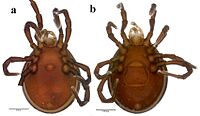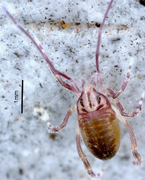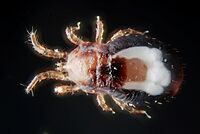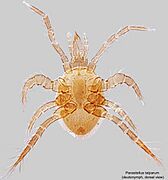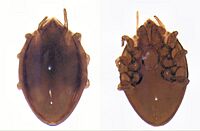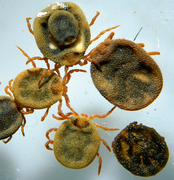Parasitiformes facts for kids
Quick facts for kids Parasitiformes |
|
|---|---|
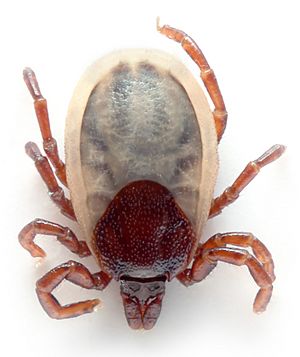 |
|
| An Ixodes hexagonus tick | |
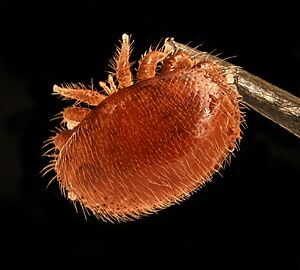 |
|
| Varroa destructor (Mesostigmata) | |
| Scientific classification |
|
| Kingdom: | Animalia |
| Phylum: | Arthropoda |
| Subphylum: | Chelicerata |
| Class: | Arachnida |
| Subclass: | Acari |
| Superorder: | Parasitiformes Leach, 1815 |
| Orders and main families | |
|
|
Parasitiformes are a fascinating group of tiny creatures. They are a type of Arachnid, which means they are related to spiders and scorpions. You might know them better as mites! Parasitiformes are one of the two main types of mites.
Many Parasitiformes are very small, but some are quite famous. For example, ticks belong to this group. Ticks are well-known for attaching to animals and feeding on their blood. However, not all Parasitiformes are parasites. Many are helpful predators, and some even eat fungi or pollen. This group is incredibly diverse, with tens of thousands of species found all over the world.
Contents
What Are Parasitiformes?
Parasitiformes are a major group of Arachnids. They are often called mites. Scientists sometimes group them differently, but they are always considered a very important part of the arachnid family.
Scientists are still studying how closely related Parasitiformes are to another big group of mites called Acariformes. In many studies, Parasitiformes seem to be more closely related to other arachnids than to Acariformes.
Meet the Mites: Different Types of Parasitiformes
The Parasitiformes group includes many different kinds of mites. Some of the most well-known members are ticks. However, the group called Mesostigmata is the largest. It has over 8,000 described species! This group includes species that affect things important to people, like the varroa mite, which can harm honeybees.
There are over 12,000 species of Parasitiformes that scientists have already described. Experts believe there could be between 100,000 and 200,000 species in total!
Ticks: The Best-Known Parasitiformes
Ixodida is the scientific name for ticks. Ticks are probably the most famous Parasitiformes. They are known for being parasites, meaning they live on other animals and feed on their blood.
Mesostigmata: Tiny Helpers and Hunters
The Mesostigmata group is very large and diverse. About half of the 10,000 known species in this group are predators. They hunt other small creatures. These mites often live hidden in places like soil, rotting wood, animal waste, dead animals, nests, or even house dust. Some species have changed their diet to eat fungi or consume spores and pollen.
A special type of Mesostigmata mite, called phytoseiid mites, is very useful. Farmers use them for biological control. This means these mites help control pests on plants naturally, without needing many chemicals.
Other Interesting Parasitiformes
- Holothyrida: This is a smaller group of mites. They are scavengers, meaning they clean up by eating dead things. They are found in places that were once part of a supercontinent called Gondwana.
- Opilioacarida: This is a small group of mites that are known for being larger and having long, segmented legs.
A Look Back in Time: Parasitiformes History
The oldest known fossils of Parasitiformes are about 100 million years old. These fossils were found preserved in amber from the Cretaceous period. They show us that three of the four modern groups—Ixodida, Mesostigmata, and Opilioacarida—existed back then.
Scientists think that Parasitiformes probably became diverse much earlier than 100 million years ago. The differences in their DNA suggest they might have originated even further back, during a very long time ago called the late Paleozoic era.
Gallery


